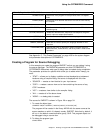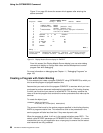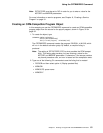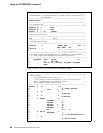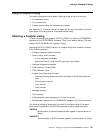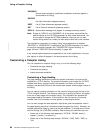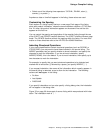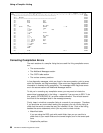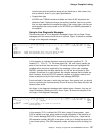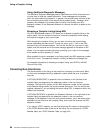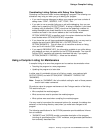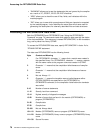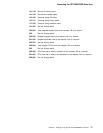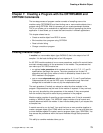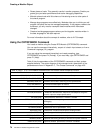
Using a Compiler Listing
Lists the start and end positions along with the literal text or field names. Use
this to check for errors in your output specifications.
Compile-time data
ALTSEQ and FTRANS records and tables are listed. NLSS information and
tables are listed. Tables and arrays are explicitly identified. Use this to confirm
that you have specified the compile-time data in the correct order, and that you
have specified the correct values for the SRTSEQ and LANGID parameters to
the compiler.
Using In-Line Diagnostic Messages
There are two types of in-line diagnostic messages: finger and non-finger. Finger
messages point out exactly where the error occurred. Figure 34 shows an example
of finger in-line diagnostic messages.
Line <---------------------- Source Specifications ----------------------------><---- Comments ----> Do Page Change Src Seq
Number ....1....+....2....+....3....+....4....+....5....+....6....+....7....+....8....+....9....+...10 Num Line Date Id Number
63 C SETOFF _12___ 003100
======> aabb
======> cccccc
*RNF5051 20 a 003100 Resulting-Indicator entry is not valid; defaults to blanks.
*RNF5051 20 b 003100 Resulting-Indicator entry is not valid; defaults to blanks.
*RNF5053 30 c 003100 Resulting-Indicators entry is blank for specified
Figure 34. Sample Finger In-Line Diagnostic Messages
In this example, an indicator has been incorrectly placed in positions 72 - 73
instead of 71 - 72 or 73 - 74. The three fingers 'aa', 'bb', and 'cccccc' identify the
parts of the line where there are errors. The actual columns are highlighted with
variables which are further explained by the messages. In this case, message
RNF5051 indicates that the fields marked by 'aa' and 'bb' do not contain a valid
indicator. Since there is no valid indicator the compiler assumes that the fields are
blank. However, since the SETOFF operation requires an indicator, another error
arises, as pointed out by the field 'cccccc' and message RNF5053.
Errors are listed in the order in which they are found. As a general rule, you should
focus on correcting the first few severity 30 and 40 errors, since these are often the
cause of other errors.
Non-finger in-line diagnostic messages also indicate errors. However, they are not
issued immediately following the line in error. Figure 35 shows an example of the
non-finger in-line diagnostic messages.
Line <---------------------- Source Specifications ----------------------------><---- Comments ----> Do Page Change Src Seq
Number ....1....+....2....+....3....+....4....+....5....+....6....+....7....+....8....+....9....+...10 Num Line Date Id Number
1 D FLD1 S +5 LIKE(FLD2) 000100
2 D FLD2 S D 000200
*RNF3479 20 1 000100 A length adjustment is not allowed for a field of the
specified data type.
Figure 35. Sample Non-Finger In-Line Diagnostic Messages
In this example, FLD1 is defined like FLD2 with a length 5 bytes greater. Later,
FLD2 is defined as a date, which makes the length adjustment in the definition of
FLD1 invalid. Message RNF3479 is issued pointing at listing line 1. Note that the
SEU sequence number (000100) is also given, to aid you in finding the source line
in error more quickly. (The SEU sequence number can also be found at listing line
1).
Chapter 6. Creating a Program with the CRTBNDRPG Command 67



